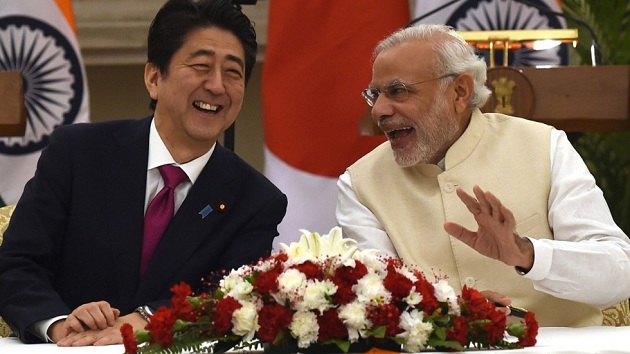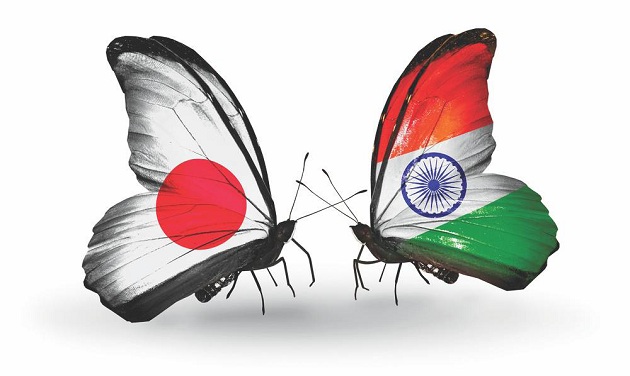Why Japan-India is a perfect alliance
Japan is looking to boost trade and investment ties with India. The following factors are being bringing Japan to the shores of Indian Markets:
- India’s courtyard is a large domestic market for investments by Japanese companies, a major driving factor. The majority of investments are in traditional fields like machinery, automobiles and auto parts.
- Japan has an ageing population with 23% above 65 years age group while India is vibrating with young blood with over 65% of total population below 35 years age.

- India has a rich spectrum of human capital to offer to a labour scarce but capital abundant Japan.
- India’s prowess in the software sector compliments to Japan’s excellence in the hardware sector.
- India’s abundance of raw materials and minerals coming together with Japan’s capabilities in technology and capital to produce knowledge-intensive manufactured goods is a win-win proposition.
- Japanese small and medium enterprises have begun to discover India as the new growth market. This is aptly illustrated by the fact that there has been an increase in the number of joint declarations, delegation visits and other business events between the two countries.
Japanese FDI into India has mainly been in automobile, electrical equipment, telecommunications, chemical and pharmaceutical sectors:
| Year | Japanese FDI in India (million US$) | % Change |
| 2001 | 150 | (-) 14.3 |
| 2002 | 146 | (-) 2.7 |
| 2003 | 124 | (-) 15.1 |
| 2004 | 139 | 12.1 |
| 2005 | 266 | 91.4 |
| 2006 | 512 | 92.5 |
| 2007 | 1506 | 194.1 |
| 2008 | 5551 | 268.6 |
| 2009 | 3664 | (-) 34.0 |
| 2010-11 | 2864 | (-) 21.8 |
| 2011-12 | 2326 | (-) 18.8 |
| 2012-13 | 2786 | 19.8 |
| 2013-14 | 1718 | (-) 38.36 |
| 2014-15 | 2084 | 21.3 |
| 2015-16
|
2614 | 25.4 |
Japan has been the largest bilateral donor to India since 1958, and under the Official Development Assistance, a programme started to aide developing nations with supplies, civil engineering and other assistance, ODA, supports India’s efforts for accelerated economic development particularly in priority areas like power, transportation, environmental projects and projects related to basic human needs.
A noticeable positive trend in these years is that even as amount committed has stabilized or gone down somewhat, actual disbursement has increased. From 2007-08, Japanese side has introduced a Double Track Mechanism for providing ODA loans which allows us to pose project proposals to the Japanese side twice in a financial year. The interest rates applicable from April 2013 are: 1.4% per annum of general projects with a 30 years tenure including a grace period of 10 years.
Japan and India in Electronics Trade
In a Joint Statement made on the 30th day of April, 2015, Ministry of Electronics and IT, India and the Ministry of Economy, Trade and Industry of Japan shared the view of both countries that could create win-win situation in IT and Electronic manufacturing field where Japanese manufacturing and Indian IT business can have synergy. Furthermore, in new frontier of IT such as Internet of Things (IoT) and Big Data, high skilled Indian IT engineer and entrepreneurs can boost Indian and Japanese companies’ creative business activities and promote innovation.
In December, 2015, India Electronics and Semiconductor Association, IESA, the premier trade body representing Electronic System Design and Manufacturing (ESDM) industry had announced signing of a MoU with Asia Semiconductor Trading Support Association (ASTSA) to promote ESDM industry collaborations between India and Japan.
Under the MOU, IESA would be enabling either of the association to jointly promote the interest of semiconductor subjects, pertaining to Indian and Japan markets. Members said the tie up would enable both bodies to promote ESDM ecosystem in Indian and Japan and strengthen business relationship among the member companies. The engagement would also provide an opportunity to the member companies of the both the associations to jointly work towards a mutually beneficial activity in the electronics industry and empower knowledge exchange. Commenting on the collaboration, MN Vidyashankar, president of IESA said, “Japan has already established itself as a global leader in the ESDM landscape”.
The Commerce and Industry Minister Nirmala Sitharaman recently stated that, the pace of implementation of Indo-Japan free trade agreement needs to be further enhanced in order to exploit the huge potential of the pact. She also feels India-Japan Comprehensive Economic Partnership Agreement (CEPA) has been rather steady and needed to be enhanced with faster pace to tap the huge potential of India- Japan bilateral trade.
What Japanese Companies have to say
The number of Japanese affiliated companies in India has grown significantly in recent years. As of March 2016, there were 1,209 Japanese companies that are registered in India. These companies had 3,961 business establishments that are operating in India, which is an increase of 1,419 establishments (56%) compared to 2013.
Japanese private-sector’s interest in India is rising and currently, about 1305 Japanese companies have branches in India.
Teru Sato, president and Group CEO, Beenos India, the global incubation and investment wing of Japan’s largest e-commerce conglomerate Netprice.com, says, “This is the right time to be in India. The Indian market is exactly where China was in 2000-2001. I think the Indian market is much more profound in terms of variety, and business opportunities. It is a much deeper market because of certain traits such as a huge population, and talent in the engineering segment. With NRIs returning back to India and wanting to play into the internet space having worked with global firms like Google, Amazon and others business opportunities are huge.” The investment firm expects Indian entrepreneurs to be a fifth of its investment portfolio in the next three to five years.
Sato believes that India will see more participation from Japanese investors, who till now have been on the sidelines. “After China and the US, India is the largest internet population, it also is the region that has the third largest communities on line. Add to this a rising middle class, this allows for huge opportunities for Internet-based businesses. Add to this there is a tremendous jump in mobile usage, next big opportunity is mobile business model. Finally, with the government of the two nations now coming together for collaboration there will a huge push by firms in Japan to collaborate with Indian firms,” he added.
Japanese firms have been actively eyeing Indian firms as they expand to other Asian market. According Vikram Upadhyay, board, member, Indian Angel Network, and a serial entrepreneur who has spent around 14 years in Japan, expects that 2014 will see around $350 million worth of PE/VC deals in e-com and tech space by Japanese investors.
In November last year Japanese consumer electronics player Hitachi bought out Chennai- based payment solutions firm Prizm payment services. JAFCO Ventures, one of the largest VC firms in Japan, part of the Nomura Group, has invested in more than a half-a-dozen technology companies in India including internet firm Apnapaisa.com, tech start-ups such as Vignani Technologies, and Microland.
What to be taken care of
Experts views on how to take Indo-Japan Relation Strong and Firm:
- Any future agreement should not only focus on increasing trade and investment flows between the two economies by removing the existing barriers on both sides but should also emphasize co-operation and technical collaboration in various sectors.
- Co-operation is needed especially in those sectors in which trade complementary is high, and this should be done through both government and private initiatives.
- Japan and India could collaborate in the fields of biotechnology, nano-technology, automobile, aerospace, and other industries. India’s fast-expanding economy will create a large demand for energy.
- The agreement is expected to increase exchanges in IT, ITES, financial services, construction, transportation and health-care services.
- Both India and Japan need to tap the huge potential that exists for further development since both bilateral trade and investment are below potential considering the economic size of the two countries.
- India must transform its overall infrastructure to global standards, to attract Japanese investment, and power facilities and telecommunication facilities needs to be upgraded further.
- Three key areas which India needs to address urgently for a comprehensive economic reforms includes: labor, infrastructure and land.








